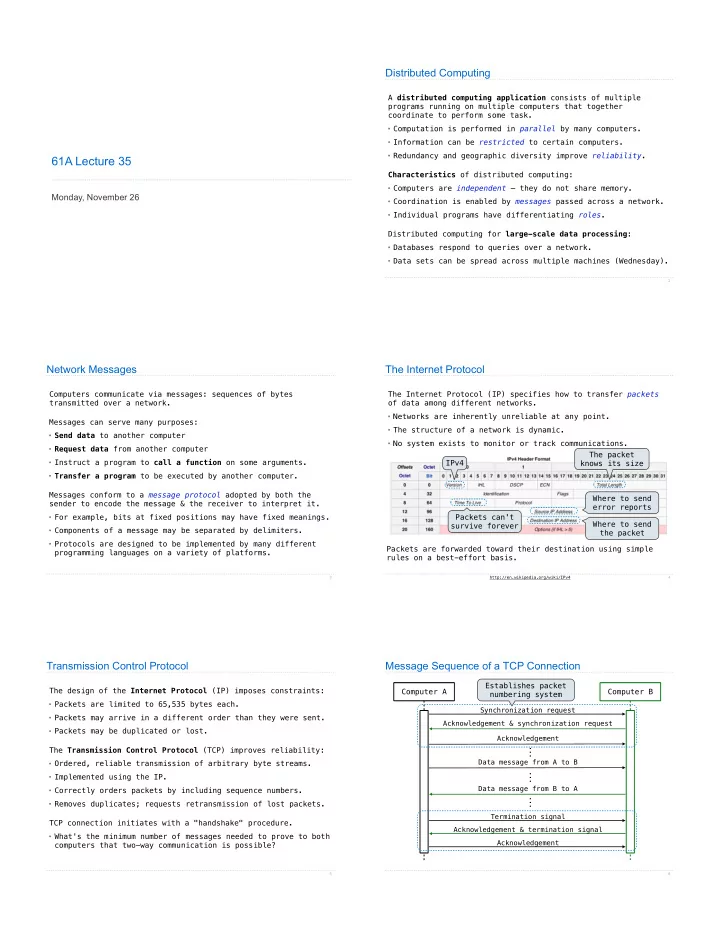

Distributed Computing A distributed computing application consists of multiple programs running on multiple computers that together coordinate to perform some task. • Computation is performed in parallel by many computers. • Information can be restricted to certain computers. • Redundancy and geographic diversity improve reliability . 61A Lecture 35 Characteristics of distributed computing: • Computers are independent — they do not share memory. Monday, November 26 • Coordination is enabled by messages passed across a network. • Individual programs have differentiating roles . Distributed computing for large-scale data processing : • Databases respond to queries over a network. • Data sets can be spread across multiple machines (Wednesday). 2 Network Messages The Internet Protocol Computers communicate via messages: sequences of bytes The Internet Protocol (IP) specifies how to transfer packets transmitted over a network. of data among different networks. • Networks are inherently unreliable at any point. Messages can serve many purposes: • The structure of a network is dynamic. • Send data to another computer • No system exists to monitor or track communications. • Request data from another computer The packet • Instruct a program to call a function on some arguments. IPv4 knows its size • Transfer a program to be executed by another computer. Messages conform to a message protocol adopted by both the Where to send sender to encode the message & the receiver to interpret it. error reports • For example, bits at fixed positions may have fixed meanings. Packets can't Where to send survive forever • Components of a message may be separated by delimiters. the packet • Protocols are designed to be implemented by many different Packets are forwarded toward their destination using simple programming languages on a variety of platforms. rules on a best-effort basis. 3 http://en.wikipedia.org/wiki/IPv4 4 Transmission Control Protocol Message Sequence of a TCP Connection Establishes packet The design of the Internet Protocol (IP) imposes constraints: Computer A Computer B numbering system • Packets are limited to 65,535 bytes each. Synchronization request • Packets may arrive in a different order than they were sent. Acknowledgement & synchronization request • Packets may be duplicated or lost. Acknowledgement The Transmission Control Protocol (TCP) improves reliability: ... Data message from A to B • Ordered, reliable transmission of arbitrary byte streams. • Implemented using the IP. ... Data message from B to A • Correctly orders packets by including sequence numbers. ... • Removes duplicates; requests retransmission of lost packets. Termination signal TCP connection initiates with a "handshake" procedure. Acknowledgement & termination signal • What's the minimum number of messages needed to prove to both Acknowledgement computers that two-way communication is possible? 5 6
Client/Server Architecture Client/Server Example: The World Wide Web One server provides The client is a web browser (e.g., Firefox): information to multiple • Request content from a location on behalf of the user. clients through request • Display the content to the user. and response messages. The server is a web server (e.g., www.nytimes.com) Server role : Respond to service requests with • Respond with (perhaps personalized) content at that location. requested information. Web browser Web server Client role: Request information and make TCP Initialization Handshake use of the response. HTTP GET request of content Abstraction: The client knows what service a HTTP response with content server provides but not how it is provided. Follow-up requests for auxiliary content ... Demo 7 8 The Hypertext Transfer Protocol Properties of a Client/Server Architecture The Hypertext Transfer Protocol (HTTP) is a protocol designed Benefits : to implement a Client/Server architecture. • Creates a separation of concerns among components. • Enforces an abstraction barrier between client and server. • A centralized server can reuse computation across clients. Uniform resource locator (URL) Liabilities : Browser issues a GET request to www.nytimes.com for the • A single point of failure: the server. content (resource) at location "pages/todayspaper". • Computing resources become scarce with increasing demand. Server response contains more than just the resource itself: • Status code, e.g. 200 OK, 404 Not Found, 403 Forbidden, etc. Common use cases : • Date of response; type of server responding • Databases — The database serves responses to query requests. • Last-modified time of the resource • Open Graphics Library (OpenGL) — A graphics processing unit (GPU) serves images to a central processing unit (CPU). • Type of content and length of content • File and resource transfer: HTTP, FTP, email, etc. Demo 9 10 Peer-to-Peer Architecture Network Structure Concerns All participants in a distributed application contribute Some data transfers on the Internet are faster than others. computational resources: processing, storage, and network. The time required to transfer a message through a peer-to-peer Messages are relayed through a network of participants. network depends on the route chosen. Each participant has only partial knowledge of the network. 11 12 http://en.wikipedia.org/wiki/File:P2P-network.svg http://en.wikipedia.org/wiki/File:P2P-network.svg
Example: Skype Skype is a Voice Over IP (VOIP) system that uses a hybrid peer-to-peer architecture. Login & contacts are handled via a centralized server. Conversations between two computers that cannot send messages to each other directly are relayed through supernodes . Any Skype client with its own IP address may be a supernode. Clients behind A client not behind firewalls cannot a firewall may be Client C communicate directly used as a supernode Client A Client B 13
Recommend
More recommend